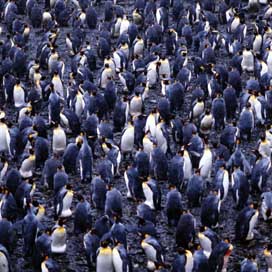Emperor Penguin
Scientific Name: Aptenodytes forsteri
Size
Emperor penguins can be 3 to 4 feet (90 to 120 cm) tall. They can weigh 50 to
100 pounds (23 to 45kg)

Where they found?
Emperor penguins may spend their entire lives in the seas surrounding
Antartica.
What do they eat?
Emperor penguins eat a variety of fish and squid
Main Predators
The Emperor penguin's main predators are Sea Leopards and Killer Whales.
Who's got the egg?

Emperor penguins have a unique incubation process. The female lays the egg.
She immediately passes it over to the male and heads out to sea to feed. The
male incubates the egg on his feet under a flap of skin on his belly for
about 60 days. When the female returns the egg is passed back and the male
then goes out to sea to feed. After that they both care for the egg until it
is able to enter water and find food for itself.
Remember, during the incubation period, the male's one and only job is to
keep the egg warm. He doesn't get to swim, feed, walk around - do anything.
During this time he can lose up to 1/3 to 1/2 of his body weight. One of the
coolest things about the male is if the chick hatches before the female gets
back he can produce a curd-like substance to feed the chick. If the female
doesn't return in time the male has to abandon it to preserve his own life.

Highlights
Emperor penguins are the largest spieces of penguin. Like other penguins,
they spend most of their time at sea. Emperor penguins can dive up to 900
feet (274 meters) (one was recorded at 1,700 feet (518 meters)) and stay
under water for several minutes. Although substantially heavier than the King
penguin, it has relatively smaller wings, feet and bill, factors favouring
heat retention. Emperor penguins normally walk bolt upright, but if alarmed
they drop down and "toboggan," using wings and legs to propel themselves.
Back To Top Of Page
Back To Main Menu



